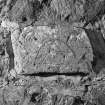Pricing Change
New pricing for orders of material from this site will come into place shortly. Charges for supply of digital images, digitisation on demand, prints and licensing will be altered.
Upcoming Maintenance
Please be advised that this website will undergo scheduled maintenance on the following dates:
Thursday, 9 January: 11:00 AM - 3:00 PM
Thursday, 23 January: 11:00 AM - 3:00 PM
Thursday, 30 January: 11:00 AM - 3:00 PM
During these times, some functionality such as image purchasing may be temporarily unavailable. We apologise for any inconvenience this may cause.
Dunnicaer
Pictish Symbol Stone (Pictish)
Site Name Dunnicaer
Classification Pictish Symbol Stone (Pictish)
Alternative Name(s) Dun-na-caer; Stonehaven; Dinnacair
Canmore ID 319617
Site Number NO88SE 2.03
NGR NO 8821 8464
Datum OSGB36 - NGR
Permalink http://canmore.org.uk/site/319617
- Council Aberdeenshire
- Parish Dunnottar
- Former Region Grampian
- Former District Kincardine And Deeside
- Former County Kincardineshire
Dunnicaer 3, Aberdeenshire, Pictish symbol stone
Measurements: H 0.23m, W 0.39m
Stone type: red sandstone
Place of discovery: NO 884 847
Present location: built into a garden wall at Banchory House (now Beannachar).
Evidence for discovery: one of a number of stones found in a rough wall on Dunnicaer in 1832 and thrown over the cliff into the sea. This stone was recovered from the shore in 1858 and was taken to Banchory House.
Present condition: good.
Description
This small rectangular slab is incised with a crescent and traces of a V-rod, with a superimposed triangle.
Date: seventh century.
References: Stuart 1867, pl 15; ECMS pt 3, 200; Fraser 2008, no 18.3.
Compiled by A Ritchie 2017
Reference (1980)
There are several descriptions of these stones; that (no. 4) bearing a double disc and Z-rod is in the Anthropological Museum, University of Aberdeen, while the others are at Banchory House (NJ 915 024).
No. 1 measures 0.69m x 0.46m and is incised with the double disc and Z-rod, rudely drawn, but with unusual flourishes.
No. 2 measures 0.68m x 0.38m and is incised with the fish symbol, having a triangle with a central dot above the head.
No. 3 measures 0.46m x 0.23m and bears a crescent symbol crossed with an equilateral triangle.
No. 4 measures 0.68m x 0.38m and bears the double disc and Z-rod symbol.
No. 5 measures 0.38m x 0.15m and bears a rough approximation of the double disc symbol.
No. 6 is nearly cubical in shape, measuring 0.1m each way. It bears on the front a circle and the end of a Z-rod; on the back, a circle and the letter 'R'?; on the right side, a circle (or the letter 'Q') with a small cross, and on the left, a 'T' combined with the circle as well as the cross.
Information from R Jones 1980; RCAHMS 1994.
Reference (1997)
On No.3, the left-hand stone, is a small equilateral triangle pointing up into a plain crescent.
A Mack 1997










